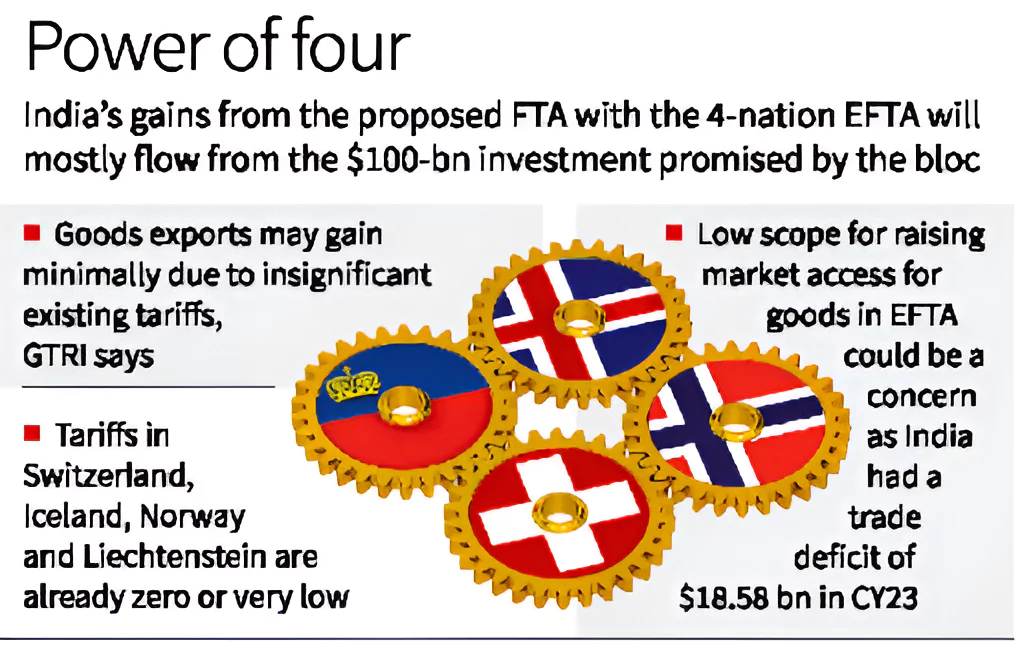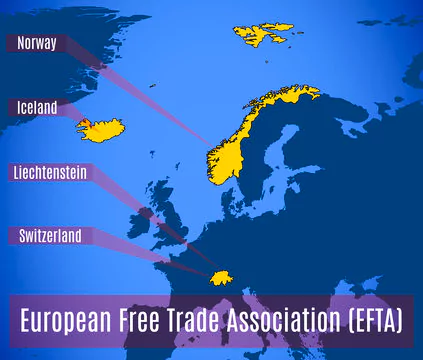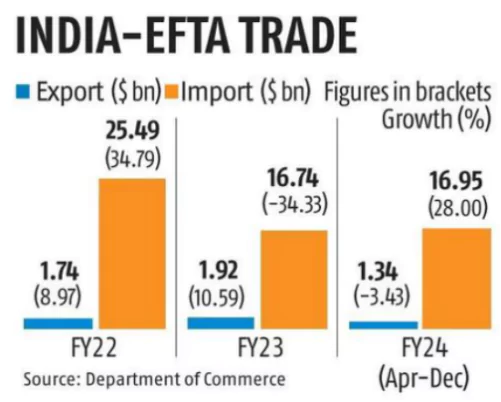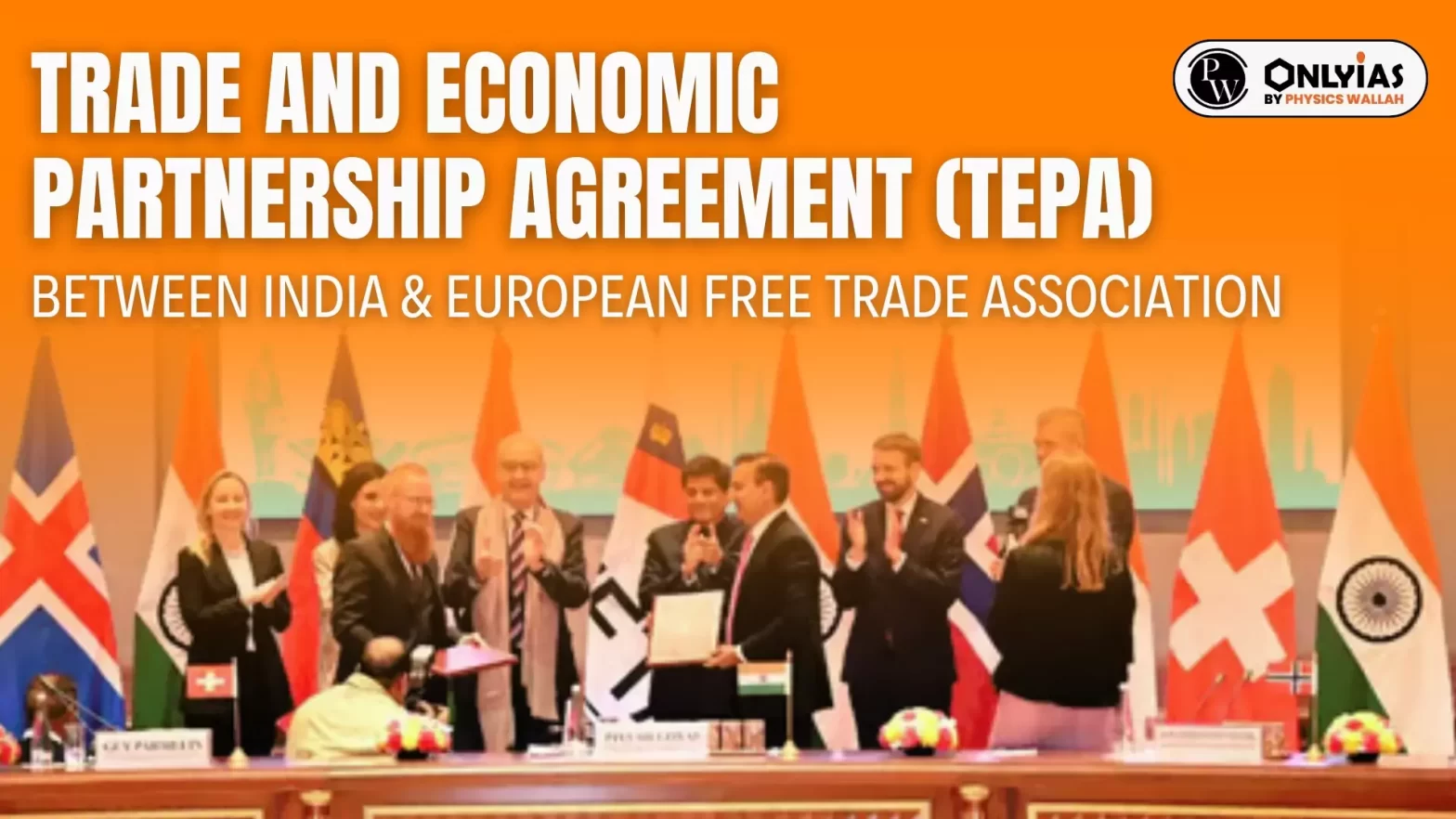Context
This Article is based on the news “India seals pact with 4-nation Europe trade group: $100 bn & 10 lakh jobs in 15-yr deal” which was published in the Indian Express. Recently, India and the four-nation European Free Trade Association (EFTA), an intergovernmental grouping of Iceland, Liechtenstein, Norway and Switzerland, signed a Trade and Economic Partnership Agreement (TEPA).
India EFTA Trade and Economic Partnership Agreement
- The negotiations for this Trade and Economic Partnership Agreement (TEPA) began in 2008, with 13 rounds of talks held until 2013. After a hiatus, negotiations resumed in October 2023 and concluded swiftly.
- TEPA is the fourth major deal signed by India to promote trade and economic cooperation in the last three years. The others are with Australia, Mauritius and the UAE.
- EFTA, though not part of the European Union (EU), is an organization that promotes free trade among its member countries.
Crucial Insights of the Trade and Economic Partnership Agreement (TEPA)

-
An Investment Commitment:
-
Aim:
- The Trade and Economic Partnership Agreement enhances market access and simplifies customs procedures, making it easier for Indian and EFTA businesses to expand operations in the respective markets.
- It also aims to facilitate and promote investment opportunities between the countries.
-
Covered Aspects Under Trade and Economic Partnership Agreement (TEPA)
- The deal covers various aspects such as trade in goods, rules of origin, intellectual property rights, services, investment promotion, government procurement, technical trade barriers, and trade facilitation.
- The trade deal also covers gender and environmental aspects.
-
Investment Fund:
- It would largely come from provident funds in EFTA countries.
- These include Norway’s $1.6-trillion sovereign wealth fund, the world’s largest pension fund, which posted a record profit of $213 billion in 2023 due to its investments in technology stocks.
- However, it may not be legally binding and falls under “investment promotion”.
- The EFTA deal excludes crucial pension and wealth funds that could have given greater confidence to investors.
- For greater certainty, parties recognise that sovereign wealth funds are excluded from the promotion obligations undertaken by the EFTA states.
-
First Free Trade Agreement (FTA):
- For the first time, India is signing FTA with four developed nations – an important economic bloc in Europe.
- An Earlier Interest: The India EFTA deal has gone through a decade after negotiations were abandoned in 2013 due to differences between the two partners after as many as 13 rounds of talks.
- A Free Trade Agreement (FTA) is an arrangement or a treaty between two or more countries to remove trade barriers and facilitate trade between them.
-
No to Data Exclusivity:
-
- India earlier rejected the four nations’ demand for the pact to include provisions on “data exclusivity” that would make it difficult for its drug companies to produce generic variants of the off-patent drugs.
-
Excludes Provisions:
- India and the EFTA also agreed to largely keep “sensitive” farm products and gold imports out of the pact.
- Sectors such as dairy, soya, coal and sensitivity related to PLI in sectors such as pharma, medical devices & processed food etc. are kept in the exclusion list.
India’s Push for Investment Commitment in the EFTA Deal

-
To Overcome Instability:
- Major geo-political shifts and a common goal to divert the economies away from their dependence on China helped India seal its first trade agreement with European countries.
- India’s imports of chemical products from China in FY23 was $20.08 bn and India imported $3.4 bn worth of medical and bulk drugs worth nearly $7 bn.
- The deal will help in diversifying imports away from China.
-
Geopolitical Opportunity:
- While India is seen as a top contender by global inventors, the Vietnam-led Association of Southeast Asian Nations (ASEAN nations) and North American nations like Mexico are also emerging as favourable investment destinations.
- A delay in streamlining investment flows and renewed attempts at global integration may turn out to be a missed geo-political opportunity.
-
To Counter Trade Deficit Scenario:
- India runs a trade deficit with most of its top trade partners, except for the US.
-
For India’s Growth:
- The $100 billion investment commitment by EFTA could help India generate economic activity and jobs in exchange for giving market access to EFTA.
- The deal could help India power its services sector further.
-
Improvement in the India-Swiss Relations:
- India hopes the pact will improve trade ties with Switzerland (the biggest partner in the EFTA).
- India is its fourth-largest trading partner in Asia and the largest in South Asia.
About the European Free Trade Association (EFTA)
- Established: In 1960, by the Stockholm Convention by its then Member States for the promotion of free trade and economic integration between its members.
- Member Countries: It is an intergovernmental organisation of Iceland, Liechtenstein, Norway and Switzerland.
- Significant Power: With a population of 13 million and combined GDP of more than $1 trillion, the EFTA nations are the world’s ninth largest merchandise trader and its fifth largest in commercial services.
- Aim: It was set up for the promotion of free trade and economic integration to the benefit of its member states and the benefit of their trading partners around the globe.
- Headquarters: Geneva, Switzerland
- Features: It works in parallel with the European Union (EU). All four member states participate in the European Single Market.
-
- However, they are not a party to the European Union Customs Union.
- All member states of EFTA are members of the World Trade Organisation (WTO).
- All four are part of the Schengen Area.
- Mandates: The main tasks of the Association are threefold:
- Regulation of Economic Relations: Maintaining and developing the EFTA Convention, which regulates economic relations between the four EFTA States.
- Managing the Agreement on the European Economic Area (EEA Agreement): This EEA Agreement brings together the EU and 3 of the EFTA States – Iceland, Liechtenstein and Norway – in a single or also referred to as Internal Market.
- For Free Trade Agreements: Developing EFTA’s worldwide network of free trade agreements (FTAs).
|
India’s Economic Relations With the EFTA Countries
- Major Trading Partner: India is the EFTA’s fifth-largest trading partner after the EU, the United States, Britain and China, with total two-way trade touching $25 billion in 2023.
- Services trade and foreign direct investment (FDI) have also reached substantial levels.
 The Statistics:
The Statistics: -
- Exports: According to government data, India’s exports to the EFTA region during January-December 2023 were worth $1.87 billion.
- Key Exports: Chemicals, iron and steel, gold, precious stones, yarns, sports goods, glassware and bulk drugs to these nations.
- Imports: India’s imports from the EFTA region was more than $20.45 billion, with Switzerland’s share alone pegged at $19,65 billion, owing to gold purchases.
- Key Imports: Gold, silver, coal, pharmaceuticals, vegetable oil, dairy machinery, medical items, crude and scientific equipment.
- On FDI: India has received about USD 10 billion of foreign direct investments (FDI) from Switzerland between April 2000 and December 2023.
- The FDI inflow was USD 721.52 million from Norway, USD 29.26 million from Iceland and USD 105.22 million from Liechtenstein during the period.
India EFTA Relations
-
India Switzerland Relations:
- Technical and Scientific Cooperation: An inter-governmental framework agreement on technical and scientific cooperation was signed and led to the launch of the Indo-Swiss Joint Research Programme.
- Skill Training Collaboration: It is facilitated through institutes such as the Bharatiya Skill Development Campus and University, Indo-Swiss Centre of Excellence in Pune and the Vocational Training Center in Andhra Pradesh.
- Economic Significance: Switzerland is the largest trading partner of India followed by Norway. It is the 12th largest investor in India.
- Switzerland is considered one of the world’s most innovative economies and has been consistently ranked number one in the Global Innovation Index.
- Bilateral Trade: It stood at USD 17.14 billion (USD 1.34 billion exports and USD 15.79 billion imports) in the last fiscal. In 2022-23, India’s trade deficit with Switzerland was USD 14.45 billion.
-
India Norway Relations:
- Focus on Blue Economy: The India-Norway Task Force on Blue Economy for Sustainable Development was inaugurated in 2020.
- Economic Significance: More than 100 Norwegian companies have been established in India.
- The Norwegian Pension Fund Global is one of India’s largest single foreign investors.
- Academic Collaborations: It exists between the Indian Institute of Technology-Madras and the Institute of Wind Energy-Chennai with institutions in Norway.
- The Norwegian company (Piql) was involved in creating a digital archive for Indian monuments.
-
India Iceland Relations:
- Diplomatic Relations: It was established in 1972 and has strengthened since 2005 with high-level visits and exchanges.
- Support in UNSC: Iceland supports India’s demand for a permanent seat at the United Nations Security Council (UNSC).
- Areas of Cooperation: Both cooperate in trade, renewable energy, science and technology, education, culture and development.
- Various agreements have been signed for more economic cooperation, such as a Double Taxation Avoidance Agreement.
- Share Political Values: Both shared common values of democracy, rule of law and multilateralism.
-
India Liechtenstein Relations:
-
- Basis Cooperation: Both have friendly relations based on mutual respect and cooperation.
- Diplomatic Relations: It was established in 1992–93.
- Both have exchanged high-level visits to strengthen their ties.
- Economic Cooperation: The two countries have signed agreements to facilitate economic cooperation, such as a Double Taxation Avoidance Agreement.
- Support in UNSC: Liechtenstein supports India’s demand for a permanent seat at the UNSC.
|
Significance of Trade and Economic Partnership Agreement (TEPA) For India
- Boost to Export: India expects that the pact will boost exports of pharmaceuticals, garments, chemicals and machinery.
- To Attract Investment: India expects that the pact will help in attracting investments in automobiles, food processing, railways and the financial sector.
- India is looking to attract investments and get better market access for its service sector workforce.
- To Diversify Import Sources: India is looking at the EFTA deal to help diversify imports away from China. India currently depends on China for key medical imports.
- EFTA is also looking at striking joint ventures in pharma, (especially medical devices), chemicals, food processing and engineering.
- Success History: EFTA’s Trade Agreements history shows that FTAs with EFTA have been favourable for other countries.
- 29 FTAs with the EFTA are currently in operation.
- Support in UNSC: The deal will play a significant role by supporting India’s permanent membership of UNSC.
- The EFTA countries recognise India’s growth as a world leader.
- Achievement of Green Energy Target: EFTA countries can help India to meet its green growth aspirations of 50% renewable energy by 2030, with their cutting-edge technologies.
- Promotion of Democratic Values: Deeping of economic cooperation would further promote the shared democratic values such as inclusive growth, gender equality and sustainable development.
Significance of Trade and Economic Partnership Agreement (TEPA) For EFTA
- More Export: The pact allows EFTA nations the opportunity to export processed food and beverages, electrical machinery, and other engineering products.
- The pharmaceutical and medical devices industry within the bloc could also benefit.
- Gain Market Access to a Major Growth Market: The Pact will help EFTA to explore the Indian market (a potential market of 1.4 billion people) at lower tariffs, which would otherwise be high around 18%, among the highest in the world.
Challenges in India EFTA Relations
- Data Exclusivity: Data exclusivity safeguards would promote monopolization for foreign pharmaceutical companies and would be a setback for the Indian generic industry.
- The details of data exclusivity solutions remain undisclosed, raising curiosity about how the interests of both parties will be reconciled.
- It will also lead to a rise in the cost of affordable medicines in India.
Data Exclusivity:
- It refers to a clause in the agreement that puts a minimum 6-year embargo i.e., a legal prohibition on commerce on clinical trial data generated during the testing and development of a drug.
|
- Differences in Economic Structures: EFTA countries focus on high-tech industries, while India’s industries generally serve lower and middle-tech sectors and bridging the differences in the economic interests would be a formidable challenge.
- Intellectual Property Rights Protection: There is a challenge of IPR protection of the EFTA companies engaged in pharmaceuticals, biotechnology, and machinery manufacturing.
- Challenges for Market Access: Issues regarding tariffs, quotas and non-tariff barriers are impacting the free market access between the two parties.
- Regulatory Differences: There are wide-ranging differences in regulations, standards and legal frameworks between India and EFTA countries.
- Concerning Trade Deficit: India has a significant trade deficit with EFTA countries, especially driven by imports of gold and precious metals, raising concerns about the imbalance in trade relations.
- Limited Tariff Benefits: Existing zero or low tariffs in EFTA countries limit the potential gains for Indian goods exports, particularly in industrial and agricultural sectors.
- Switzerland’s policy of tariff-free entry for all industrial goods from any country, with effect from January 1, would affect benefits to Indian companies.
- India is likely to keep facing difficulties in exporting farm produce to Switzerland due to a complex web of tariffs, quality standards, and approval requirements.
Way Forward
- Addressal to Data Exclusivity Issue: The high-level delegates should work towards resolving outstanding issues such as data exclusivity to smooth future ties.
- Identify Areas of Mutual Benefit: There is a need to identify more areas of mutual benefit and cooperation must be enhanced.
- Secure Domestic Manufacturers: India needs to secure its important domestic sectors where EFTA countries have a competitive edge, such as pharmaceuticals and machinery manufacturing.
- Environmental and Social Considerations: There is a need to include and address more contemporary challenges like promoting sustainable development and gender equality.
- A Favouring Investment Commitment: With this deal, India could see higher imports of machinery, pharmaceuticals, medical instruments and machinery as there would be a sharp reduction in Indian tariffs.
- Therefore, an investment commitment is crucial as India EFTA trade is largely in favour of the European grouping as far as goods are concerned.
- Example, India runs a high trade deficit with Switzerland, which could widen after India eliminates duties as part of the deal.
- Promote Collaboration on Skilled Labour: Collaboration on Skilled Labour is crucial to achieve the threshold potential of both the parties, specially for India.
Also Read: India-Peru Trade Agreement Negotiations
| Prelims PYQ (2018):
Consider the following countries:
1. Australia
2. Canada
3. China
4. India
5. Japan
6. USA
Which of the above are among the ‘free-trade partners’ of ASEAN?
(a) 1, 2, 4 and 5
(b) 3, 4, 5 and 6
(c) 1, 3, 4 and 5
(d) 2, 3, 4 and 6
Ans: (c) |
![]() 11 Mar 2024
11 Mar 2024



 The Statistics:
The Statistics: 